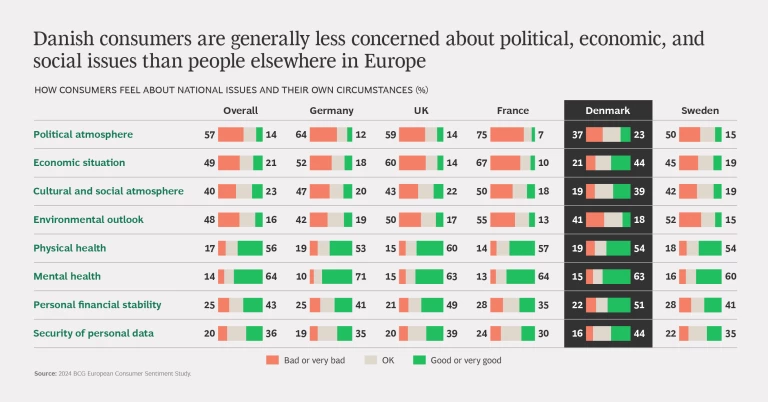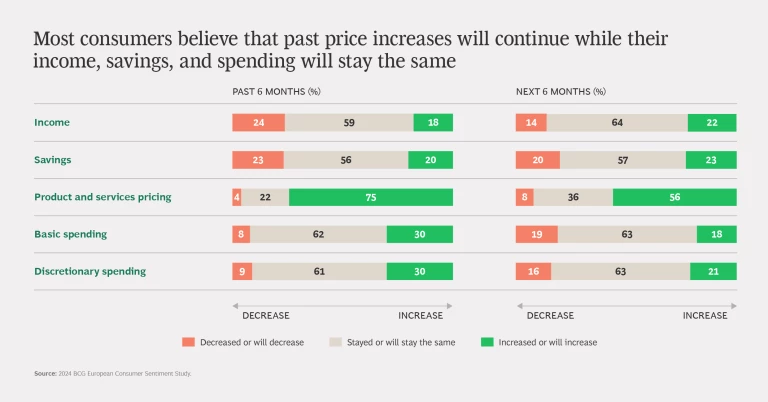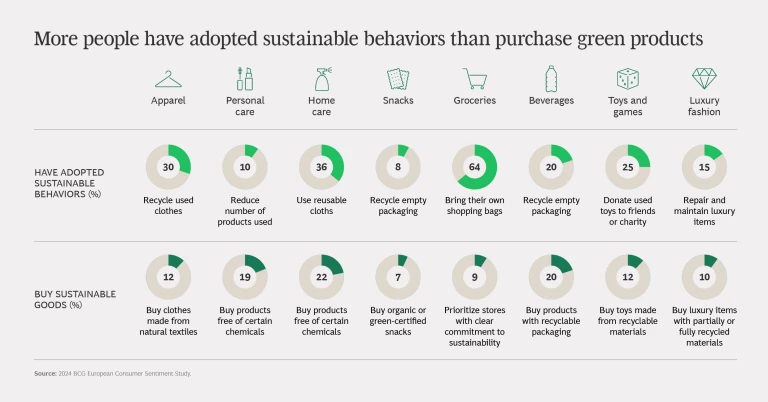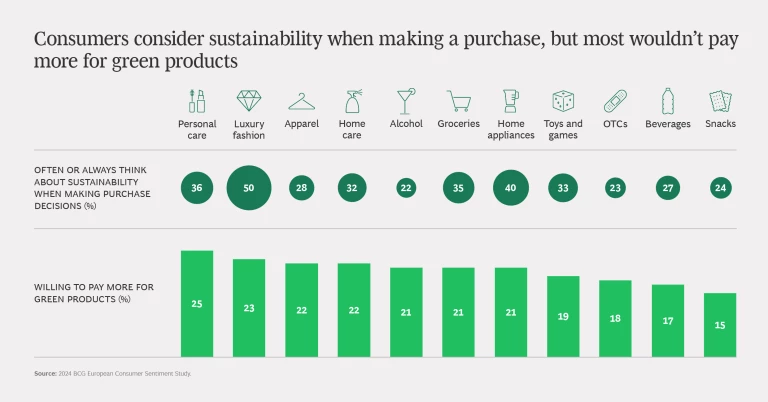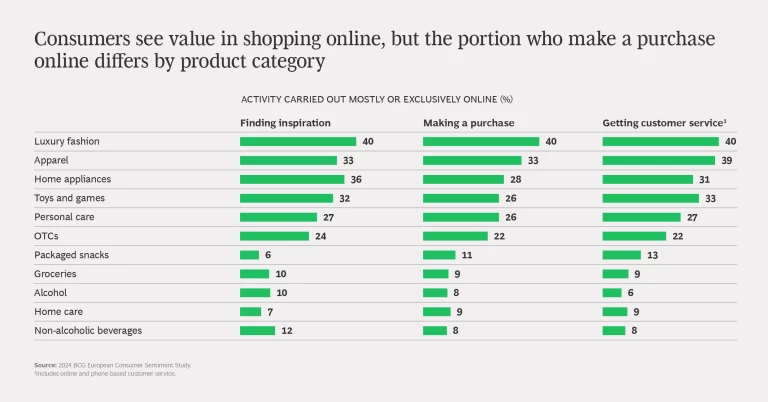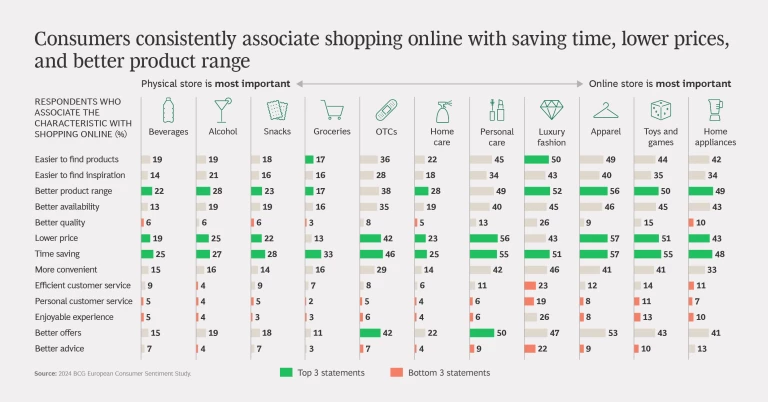This article is part of the 2024 European Consumer Sentiment Report series, which examines consumers’ shopping habits and preferences.
Something is definitely not rotten in the state of Denmark. According to new BCG research, in the first half of 2024, Danish consumers were more optimistic about the state of the country’s affairs and their own than residents elsewhere in Europe.
Danes reported feeling better about the country’s economy, energy prices, and social issues than other Europeans. They also felt better than average about their personal situation, including their financial stability.
But good feelings didn’t translate to higher spending. People saw prices rise while their incomes stayed the same. As a result, net spending dropped in all product categories but groceries and over-the-counter medications. Other shopping trends:
- To reduce spending, in the first six months of the year consumers cut back on how much they bought rather than trading down to lesser quality, lower-priced goods.
- Many Danes are embracing sustainability. Even so, the majority wouldn’t pay more for green products--they see sustainability as less critical than other key purchase considerations such as value, savings, and practicality.
- If forced to choose, more than 60% would prefer to buy something by walking into a physical store rather than an online-only merchant.
These trends are among the highlights of a consumer sentiment survey of 1,400 people in Denmark conducted July 3-15. It’s part of a larger survey of consumers in five European countries we did to understand people’s feelings about current affairs and their personal lives and how those sentiments affect shopping habits and preferences.
Danes Feel Good about the Country and Themselves
Danish consumers are the least likely of residents of any of the five countries we surveyed to feel bad about the current status of their region. Fewer than the average express apprehension about the state of their country’s politics (37% v. 57%), economy (21% v. 49%), cultural or social atmosphere (19% v. 40%), or the outlook for the environment (41% v. 48%).
Energy prices and inflation top the national issues Danish people are most concerned about. But even those worries have subsided from what they were in our 2022 and 2023 consumer surveys. (See Exhibit 1.)
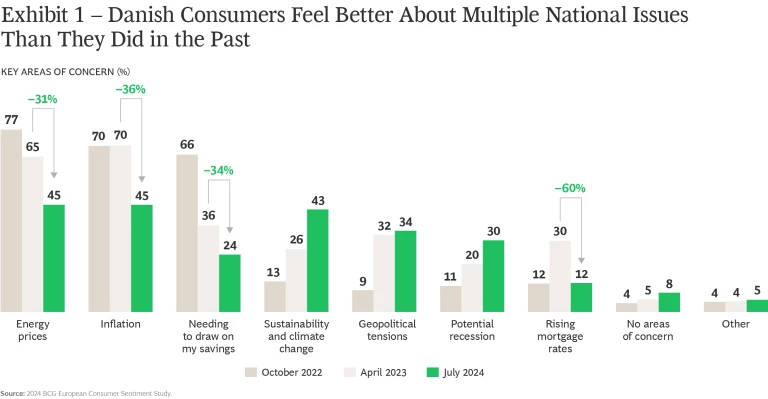
In 2024, less than half of people were concerned about energy prices (45%), compared to 77% in 2022 and 65% in 2023. Similarly, only 45% were concerned about inflation, compared to 70% in 2022 and 2023. On the other hand, the portion of people who said they are concerned about sustainability and climate change, geopolitical tensions, and potential recession has risen steadily since 2022.
Danes’ feelings about how well off they are personally are closer to the average for the five countries we surveyed, with more than half saying that their physical and mental health and personal financial stability are “good” or “very good.”
Danish consumers are less concerned about other aspects of their personal situation than in 2022 and 2023. Unlike those years, a smaller portion are concerned about the need to draw on savings to get by or worried about rising mortgage rates.
People spent more on basics and cut back on non-essentials. Three-quarters of people reported higher prices for products and services in the first half of 2024. During the same six months, people also reported that income and savings stagnated or declined.
The difference resulted in people reporting higher basic and discretionary spending. Over-the-counter medications—a necessity people can rarely forgo—was the only product category surveyed with a net spending increase, of 9% for the first half of 2024. Net spending on groceries was unchanged. (See Exhibit 2.)
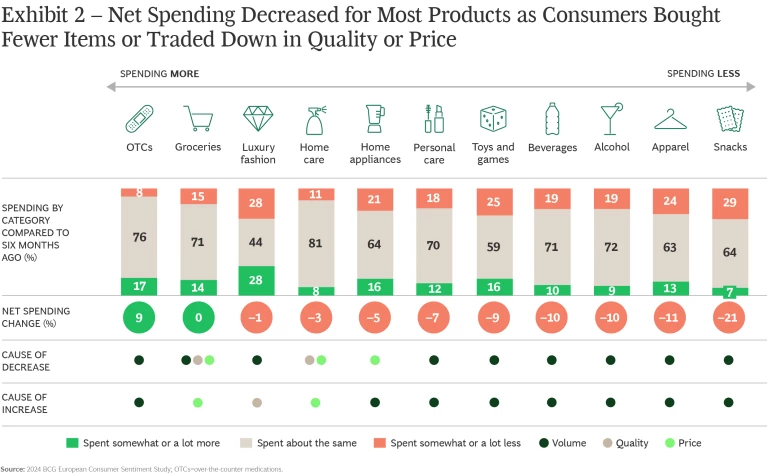
In every other product category, net spending dropped, and non-essentials were especially hard hit. Compared to the beginning of 2024, net spending was down for snacks (-21%), apparel (-11%), alcohol (-10%), beverages (-10%), and toys and games (-9%).
Danes are beginning to be hopeful that conditions are changing. Slightly more than half (56%) expect price increases to continue through December, a drop from 75% who reported price increases in the first half of the year. In the last half of 2024, 22% expect their income to increase compared to 18% who said their salaries went up in the beginning of the year, and 23% expect savings to grow, compared to 20% earlier in 2024.
Forecasts for personal finances and prices weren’t uniform across age groups. More Gen Z and Millennials than other generations expect their incomes and savings to increase through the end of 2024. Younger age groups also were less likely than older generations to expect additional price increases through the end of the year.
Stay ahead with BCG insights on the consumer products industry
Sustainability Matters But It’s Not a Substitute for Value
People in Denmark care about sustainability. At least one in five said that they often or always consider sustainability when deciding about a purchase. The portion is even greater for people shopping for luxury fashion (50%), home appliances (40%), and personal care items (36%).
Willingness to pay more for green products is a different story. Most Danes would not pay a premium for a sustainable or green product. However, a significant minority would—one in five. The portion willing to pay more is slightly higher in some product categories, including personal care items (25%), luxury goods (23%), and home care products (22%).
The disconnect between what consumers say and do springs from the factors they consider important when they shop. Danish people aspire to be green but place greater value on more traditional key purchase criteria, including getting a good deal, saving money, low price, and practicality. (See Exhibit 3.)
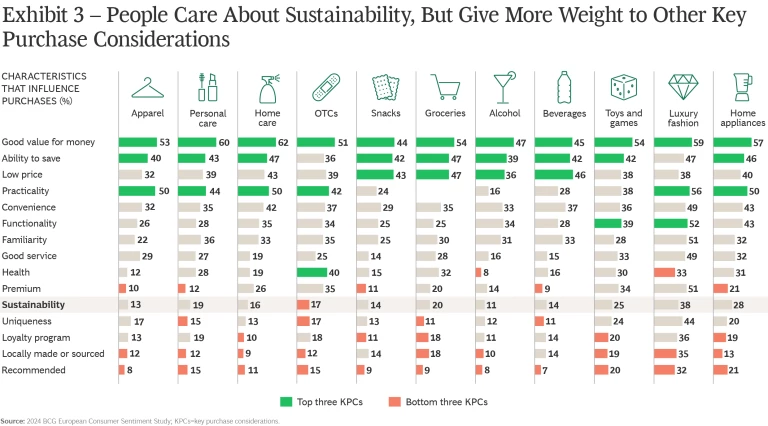
Even so, sustainability is gaining ground as a purchase criteria. Consumers give it more weight than product uniqueness, loyalty programs, being locally made or sourced, and recommendations. In some categories, including apparel, personal care, and home appliances, sustainability also outweighs premium-ness.
For grocery shoppers, sustainability’s importance is relatively unchanged from 2023: 20% of respondents consider sustainability to be an important grocery shopping consideration, compared to 21% last year. In addition, 21% would pay more for green products, compared to 19% in 2023.
Buying from a Physical Store Still Beats Shopping Online
The vast majority of Danish consumers go online for at least some part of a purchase. But if forced to choose, close to six in 10 or more would pick shopping at a physical store with no online presence over patronizing an online-only merchant. (See Exhibit 4.)
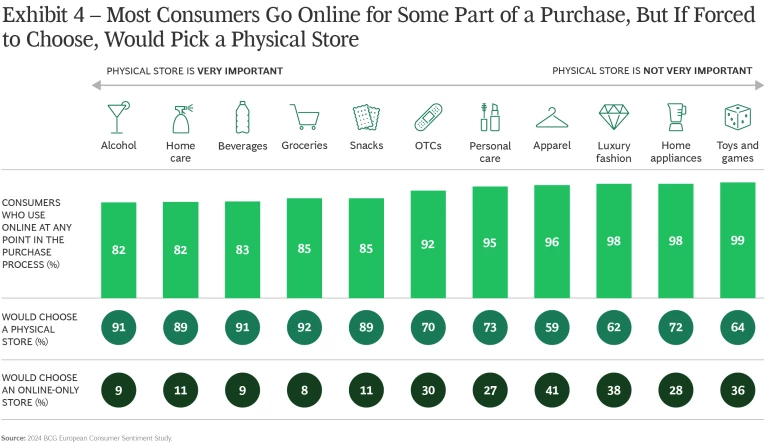
People’s preferences for online- or physical-only stores are closely tied to what they’re buying. They have a strong preference for shopping at a physical store for frequent purchases such as alcohol, home care products, groceries, and snacks because of the convenience or price, or because they may prefer getting help from a flesh-and-blood salesperson.
The equation changes for price-sensitive products that people buy less frequently or on an impulse, or when they want more options to choose from. Categories for which Danish consumers are most likely to make a purchase online are: apparel (41%), luxury fashion (38%), toys and games (36%), over-the-counter medications (30%), home appliances (28%), and personal care items (27%).
How Companies Can Woo Danish Consumers
To strengthen ties with Danish consumers and stay competitive, companies should consider acting in three areas: product assortment, pricing, and promotions. We've found that the impact is greater when companies launch changes in all three areas simultaneously. However, because of the time and resources needed, most companies choose to address one area at a time. In addition, for changes to be successful, companies need a strong data analytics foundation.
Localize product assortment. Danish consumers are spending less, especially on non-essentials. They have different preferences for where they like to shop, and many still like buying in a physical store. To adapt, companies could customize what they offer in their physical locations to meet local demand and offer a more broad, global range of products on their e-commerce platform, which could appeal to shoppers who go online to browse or be inspired. In addition to increasing customer satisfaction, such changes minimize excess inventory. Supermarkets in rural areas of Denmark, for example, often stock local specialties and products from nearby farms, catering to the preferences of customers in those regions. But the same farm products are in less demand among city shoppers, so urban supermarkets typically don't carry them.
Adopt dynamic pricing. Danes are becoming more price sensitive. Companies could use data-based dynamic pricing strategies to counter shifting consumer preferences while improving their ability to respond to fluctuating volumes, local market conditions, commodity prices, and competition.
A leading European furniture retailer adopted dynamic pricing as part of a strategy to sell lower-cost items in order to respond to inflation and consumers’ desire for more affordable home furnishings. To manufacture lower-priced products, the company intensified its cost focus across the board, including for design, material development, production, and marketing. The company used an advanced pricing engine to adjust prices dynamically to account for price sensitivities in the different regions it served. The changes enabled the company to increase sales despite continued challenges in the furniture industry.
Make promotions hyper-personalized. In addition to being more price sensitive and reluctant to buy non-essentials, consumers show less interest in loyalty programs relative to other shopping factors. Companies can counter such sentiments by individualizing loyalty programs and promotions.
Companies with successful programs use advanced analytics—including AI—to offer a level of personalization to loyalty members that other personalized promotions cannot match. The exclusivity that analytics-based promotions offer keeps consumers engaged and meets their need for good value and quality, making it more likely that they will keep shopping.
Nike’s membership program is a prime example of an AI-powered, hyper-personalized loyalty experience. People who download the free Nike membership app receive special access to exclusive products and experiences personalized to each shopper, free shipping, and more lenient return policies. In exchange, Nike collects consumer data from both the app and offline channels, which the company uses to improve its highly targeted, relevant promotions. For example, a Nike member who typically buys outerwear during the winter may get related promotions before the season starts.
Enhance data collection. To successfully launch initiatives in product assortment, pricing, and promotions, companies must improve their ability to collect rich data on consumer behaviors and preferences across sales channels. Rich data includes consumer demographics, interests, and motivational drivers; what people buy, when, how, where, and why; and how they engage with sales channels, including through promotions or loyalty programs. If they revamp their digital presence and loyalty programs, companies can use the access they have to first-party consumer data to capitalize on customer relationships in ways that in the past were not possible.
Acknowledgements
The authors would like to thank Mary Patrikiou and Martina Scrocco for their helpful comments and suggestions. The authors would also like to thank Megan Moore for conducting the research upon which this report is based.

